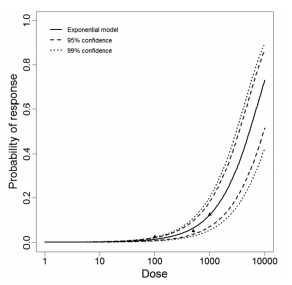| Experiment ID | Acanth_Intranasal2 |
|---|---|
| Pathogen | |
| Contains Preferred Model | 0 |
| Status | fitted |
| Reference |
| Host type | |||||||||||||||||
|---|---|---|---|---|---|---|---|---|---|---|---|---|---|---|---|---|---|
| # of Doses | 3.00 | ||||||||||||||||
| Μodel | |||||||||||||||||
| k | 1.31E-04 | ||||||||||||||||
| LD50/ID50 | 5.28E+03 | ||||||||||||||||
| Dose Units | |||||||||||||||||
| Response | |||||||||||||||||
| Agent Strain | A. castellanii HN-3 | ||||||||||||||||
| Exposure Route | |||||||||||||||||
| Experiment Dataset |
|
Culbertson et al. (1966) studied the pathogenicity of the HN-3 strain of A. castellanii (Culbertson et al., 1966; Marciano-Cabral & Cabral, 2003) on ether-anesthetized-specific-pathogen-free (SPF) mice. Cultures of amebae were grown in trypticase soy broth and diluted so that 0.03 mL of a concentrated suspension could be instilled intranasally into the mice by placing fluid over the nares (Culbertson et al., 1966; Culbertson, Ensminger, & Overton, 1965a; Culbertson, Ensminger, & Overton, 1965b).
The exponential model provided the best fit to the data.
Fig 1: Parameter histogram for exponential model (uncertainty of the parameter)
Fig 2: Exponential model plot, with confidence bounds around optimized model
Culbertson, C. G., Holmes, D. H., & Overton, W. M. (1965b). Hartmanella castellani (Acanthamoeba sp.). The American Journal of Clinical Pathology, 43(4), 361–364.
Culbertson, C. G., Ensminger, P. W., & Overton, W. M. (1966). Hartmannella (Acanthamoeba): Experimental Chronic, Granulomatous Brain Infections Produced by New Isolates of Low Virulence. The American Journal of Clinical Pathology, 46(3), 305–314.
 QMRA
QMRA 
